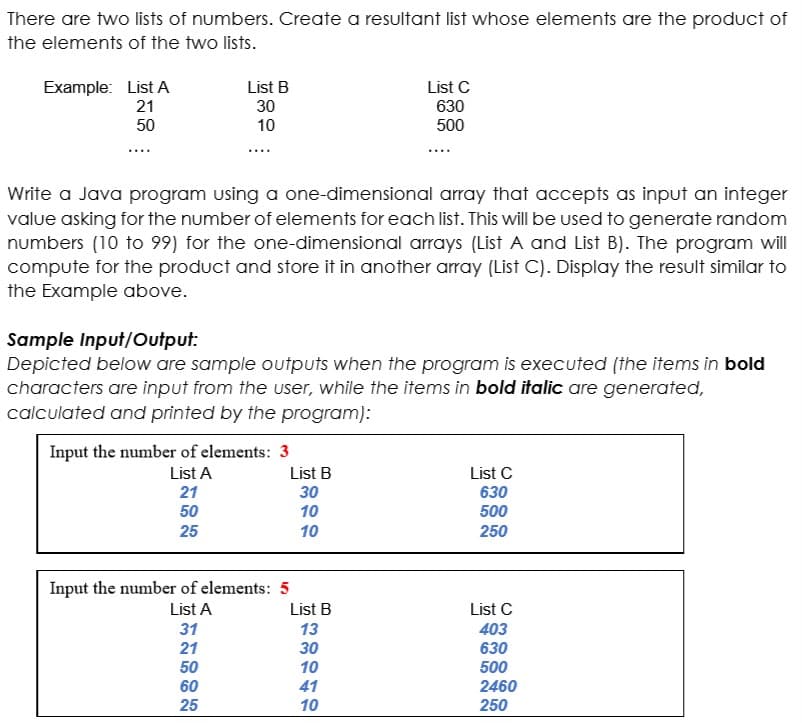There are two lists of numbers. Create a resultant list whose elements are the product of the elements of the two lists. Example: List A 21 50 List B 30 10 List C 630 500 Write a Java program using a one-dimensional array that accepts as input an integer value asking for the number of elements for each list. This will be used to generate random numbers (10 to 99) for the one-dimensional arrays (List A and List B). The program will compute for the product and store it in another array (List C). Display the result similar to the Example above.
There are two lists of numbers. Create a resultant list whose elements are the product of the elements of the two lists. Example: List A 21 50 List B 30 10 List C 630 500 Write a Java program using a one-dimensional array that accepts as input an integer value asking for the number of elements for each list. This will be used to generate random numbers (10 to 99) for the one-dimensional arrays (List A and List B). The program will compute for the product and store it in another array (List C). Display the result similar to the Example above.
C++ Programming: From Problem Analysis to Program Design
8th Edition
ISBN:9781337102087
Author:D. S. Malik
Publisher:D. S. Malik
Chapter8: Arrays And Strings
Section: Chapter Questions
Problem 11PE
Related questions
Question
100%

Transcribed Image Text:There are two lists of numbers. Create a resultant list whose elements are the product of
the elements of the two lists.
Example: List A
21
List B
List C
30
630
50
10
500
Write a Java program using a one-dimensional array that accepts as input an integer
value asking for the number of elements for each list. This will be used to generate random
numbers (10 to 99) for the one-dimensional arrays (List A and List B). The program will
compute for the product and store it in another array (List C). Display the result similar to
the Example above.
Sample Input/Output:
Depicted below are sample outputs when the program is executed (the items in bold
characters are input from the user, while the items in bold italic are generated,
calculated and printed by the program):
Input the number of elements: 3
List A
21
List B
List C
30
630
50
10
500
25
10
250
Input the number of elements: 5
List A
List B
List C
31
13
403
630
500
21
30
50
10
60
25
41
2460
10
250
Expert Solution
This question has been solved!
Explore an expertly crafted, step-by-step solution for a thorough understanding of key concepts.
Step by step
Solved in 3 steps with 1 images

Knowledge Booster
Learn more about
Need a deep-dive on the concept behind this application? Look no further. Learn more about this topic, computer-science and related others by exploring similar questions and additional content below.Recommended textbooks for you

C++ Programming: From Problem Analysis to Program…
Computer Science
ISBN:
9781337102087
Author:
D. S. Malik
Publisher:
Cengage Learning

C++ Programming: From Problem Analysis to Program…
Computer Science
ISBN:
9781337102087
Author:
D. S. Malik
Publisher:
Cengage Learning